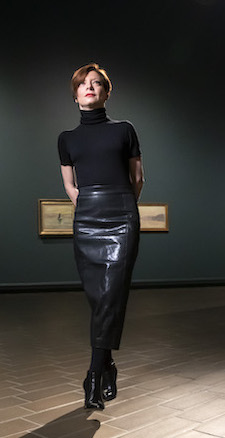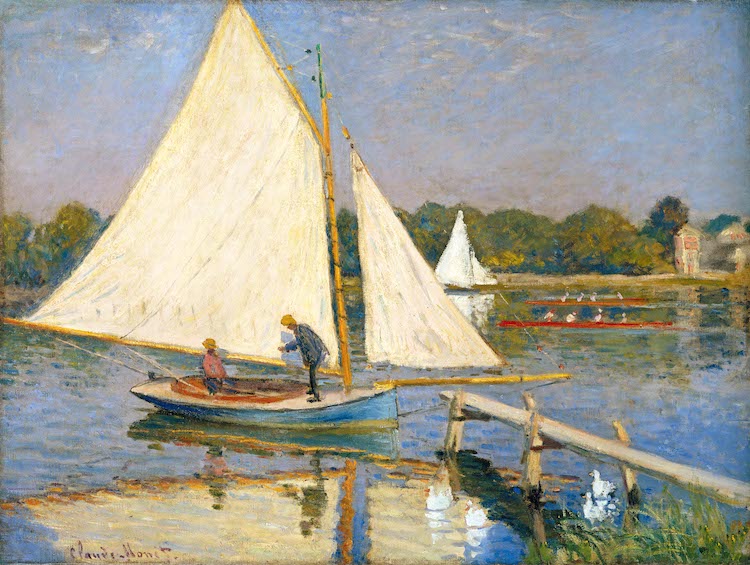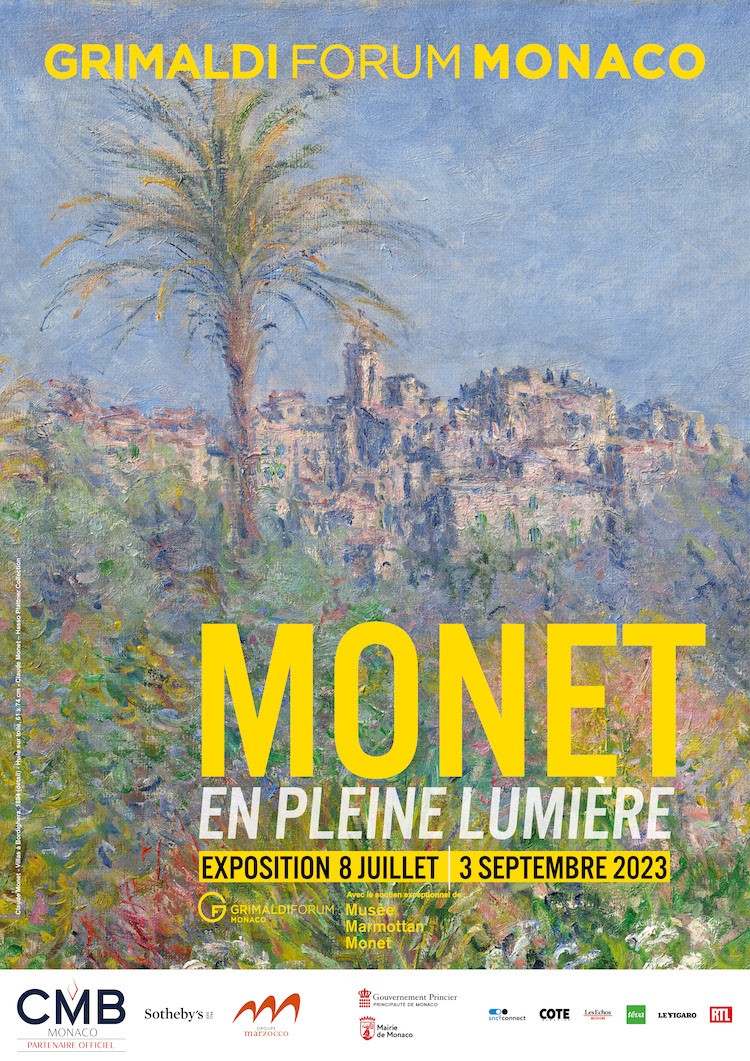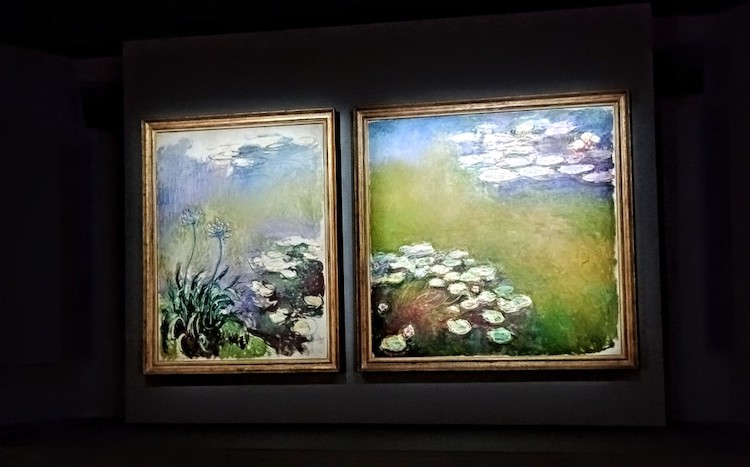With over one hundred works from all over the world, the exhibition is one of the most extensive monographs on Claude Monet this decade, and undoubtedly the most audacious.
It has become a time-honoured and much-beloved tradition: every summer, the Grimaldi Forum in Monaco mounts an exhibition that rivals the world’s greatest museums. This year, the spotlight is on Claude Monet (1840-1926) – or more specifically, on one of his favourite motifs: the unique light and vibrant beauty of the Côte d’Azur. And less than a month after its opening, the show is already a visitor magnet, attracting over 50,000 art lovers just within the first couple of week. The exhibition will run through September 3, 2023.
https://youtu.be/IDK_MFgphIk
Aptly titled “Monet En Pleine Lumière” (“Monet in Full Light”), the exhibition explores the artist’s sojourns on the Riviera from his first visit in 1883 upon invitation of his friend Pierre-August Renoir, who on that occasion also introduced him to Paul Cézanne. Like many fellow artists, Monet drew inspiration from travel, and would become obsessed with capturing the unique light of the Mediterranean. He returned for several extended visits, roaming the area from the small Italian town of Bordighera to Antibes on the French side. All in all, he created about 125 landscapes in just five years. The trail of the exhibition presents a rarely seen compilation of Monet’s work on the Riviera, juxtaposed with his masterpieces from his native northern France and his home in Giverny.
Hailing from the north of France with its muted colours, the ever-changing hues of the deep blue sea, the lush green of the native subtropical flora, and the pastel tones of the architecture were a revelation to Monet. He reveled in the golden light of the Riviera. But he also understood its fleeting quality which would only ever last for a few minutes before changing aspect.
“This landscape transformed his work and colour palette”, explains Marianne Mathieu, the curator of this exceptional exhibition. “How beautiful it is here, to be sure, but how difficult to paint! I can see what I want to do quite clearly but I’m not there yet. It’s so clear and pure in its pinks and blues that the slightest misjudged stroke looks like a smear of dirt,” the artist wrote in one of his letters. He also realized that the ubiquitous palm trees were quite bothersome – their constant motion didn’t provide him the straight vertical lines he needed to structure his paintings. He adapted though, and yet remained true to himself and authentic as an artist. “Monet didn’t try painting a motif but a moment. Monet didn’t paint a landscape but an atmosphere,” says Marianne Mathieu. The Monaco-born art historian and Monet expert is proud to bring this exceptional exhibition to her home country.
What are we going to discover in the exhibition that we don’t already know?
 Marianne Mathieu: The gathering of an exceptional number of masterpieces rarely displayed together. We were aware of the geographic scattering of Monet’s oeuvre, so the challenge was huge but the motivation wholehearted! Nearly a hundred canvases in total, dating from 1870 to 1925, and an exceptional museum space give us the opportunity to offer a new reading of the master’s oeuvre around a section devoted to his Riviera period, twenty-three paintings of the ninety or so that he painted there, a particular production that is little-known to the public. It is a historical event in two ways. Never, even during Monet’s lifetime, have so many paintings made in the South been presented in France at the same time. Gathering them at Grimaldi Forum, in Monaco, near the sites where Monet placed his easel, has opened a new field of research.
Marianne Mathieu: The gathering of an exceptional number of masterpieces rarely displayed together. We were aware of the geographic scattering of Monet’s oeuvre, so the challenge was huge but the motivation wholehearted! Nearly a hundred canvases in total, dating from 1870 to 1925, and an exceptional museum space give us the opportunity to offer a new reading of the master’s oeuvre around a section devoted to his Riviera period, twenty-three paintings of the ninety or so that he painted there, a particular production that is little-known to the public. It is a historical event in two ways. Never, even during Monet’s lifetime, have so many paintings made in the South been presented in France at the same time. Gathering them at Grimaldi Forum, in Monaco, near the sites where Monet placed his easel, has opened a new field of research.
What is your personal view on that “Riviera” period?
MM: If Claude Monet is unanimously hailed as a major painter of the 19th century, celebrated as the leader of impressionism, we know little of the complexity, the precision of a creative practice in constant evolution. This exhibition gave us the opportunity to emphasise the importance of his stay in the South. It was a key moment in his life and in his development as an artist. It was also the moment he realised his full potential.
Why is that period so particular in Monet’s œuvre?
MM: It was the moment Monet came into his own. In 1883 in Monaco, he put an end to mentoring painting. From then on, Monet worked alone and gave priority to his own impressions. The journey to Bordighera in 1884 established the principle of his recurrent painting campaigns, that took him from region to region for the two following decades. And when Monet set down his easel in Antibes in 1888, he reached the end of this type of trip, a change began and announced the revolution of the series.
How did you organise your work around that section?
MM: Carried out with the Grimaldi Forum team, complicit from day one, and thanks to the contribution of local historians specialized in the history of their area, namely André Labarrère, Carlo Bagnasco, Aldo Herlaut, Jean and Danielle Latu, who did some research, examined the local archives and went up and down those landscapes of the Riviera, some paintings have been reconsidered in their context, backed up by precise topographic location scouting.
How do you perceive the space of the Grimaldi Forum Monaco, a setting of 2,500 m²?
MM: The exhibition space is free of any limitation. I would never have had the opportunity to develop this narrative discourse without having at my disposal such freedom to structure that trail: making Monet’s approach accessible by encouraging the viewer to exercise his gaze. I wanted to offer the public a true moment of sharing and experiencing a visit using simple tools of communication accessible to all: to examine the works at close distance, to listen to the interpretation we bring forth advisedly and let’s not forget an immersive approach generated by Claude Monet’s oeuvre itself.
William Chatelain’s sober, intimate, and generously spaced scenography meanders through eight rooms, eliminating distractions and giving the viewer room to stand back and contemplate the works. The goal is to show what Monet saw, to take it the scenery through his eyes. One of the highlights is the room dedicated to the Water Lilies series, illustrating the story of that complex period in Monet’s life after the First World War by archival video, photos, music, and Monet’s own recorded voice.
This well-orchestrated, immersive exhibition takes you on a leisurely journey back in time, letting you peek over Monet’s shoulder and see the area through his eyes. But its real, unexpected magic lies in the moment when you leave, spirit still imbued with the paintings, and you suddenly notice that what you just saw on canvases dating back to the 19th century is still all around you in the vistas of the French Riviera. The golden light may be fleeting here but nature’s glory is eternal, and artists are its masterful interpreters.
PRACTICAL INFORMATION:
DATES: July 8 to September 3, 2023
HOURS: Open daily from 10:00 a.m. to 8:00 p.m.
EVENING VISITS: Thursdays until 10 p.m.
LOCATION: Ravel Hall at the Grimaldi Forum Monaco
10, avenue Princesse Grace – 98000 Monaco
ACCESSIBILITY: The exhibition is accessible to persons with reduced mobility.
PRICE OF ADMISSION: Full price: €14 (FREE for children under 18); concessions for groups, students, and seniors
All photos courtesy Grimaldi Forum unless otherwise credited;
Canotiers à Argenteuil, 1874
Huile sur toile
61,9 x 80 cm
Collection Nahmad
© crédit photo Collection Nahmad





Leave a Reply